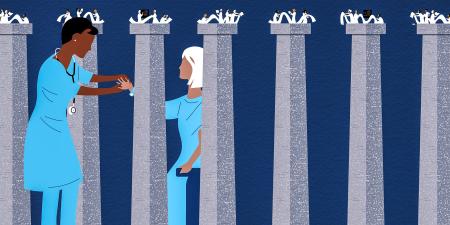Abstract
Faculty members who demonstrate resistance to or lack of skill in addressing negative bias in practice and learning environments can erode safety, especially among underrepresented students. This commentary on a case suggests how educators and leaders should respond to problematic behaviors of unwilling or unskilled faculty, prevent mistreatment of students and colleagues, and facilitate continuous faculty development. This commentary also considers strategies for motivating equity and building health care cultures of accountability.
Case
Dr H is associate dean of assessment at the University School of Medicine (USM). Over the last few years, when reviewing students’ feedback about courses in USM’s social determinants of health (SDOH) track, Dr H has seen increasing numbers of students repeatedly express concerns about course content that reinforces negative racial, ethnic, gender, and class stereotypes, especially about patients of color from under-resourced communities.
Dr H received several complaints about one faculty member—ranging from general comments about his making the learning environment uncomfortable; to his expressing condescending attitudes towards patients and using inappropriate, unprofessional, and sexist humor; to his giving more attention and learning opportunities to White male students than other students. This faculty member has also been cited for shaming underrepresented in medicine (URM) students, specifically during didactic seminars.
Dr H has also observed that this faculty member has not participated in any faculty development opportunities related to diversity, equity, and inclusion (DEI), such as the annual implicit bias training. Dr H observes inappropriate, unprofessional humor as a recurring theme in this faculty member’s course evaluations. During a recent annual performance review meeting, Dr H suggested that some students have not responded well to humor he uses during supervision. The faculty member expressed frustration: “Oh great! Now I can’t even joke around with the students anymore!”
Dr H wonders how to assist in developing a specific action plan to motivate behavior changes in this faculty member.
Commentary
Survey data suggest that cases like this one, in which students experience faculty disrespect for diversity, are not uncommon,1 and racism in academic medicine has drawn national attention.2 Despite some exceptions, there is modest but growing evidence that medical student and trainee cohorts have become increasingly diverse over the last 2 decades.3,4 As more URM students and trainees are matriculating into medical schools and hospitals, they are encountering systems that have been composed predominantly of White people since the institutions’ beginnings; this historical pattern is arguably even more pronounced in academic medical centers, which are also White-centered in their cultural norms, values, and priorities, creating unspoken and unwritten codes of conduct (ie, hidden curricula) that uphold racial hierarchies.5,6 This tension between institutional norms that center whiteness and the increasing diversity of student matriculants has been compounded by the recent rise of racial justice movements (eg, Black Lives Matter) that have created national awareness of entrenched structural racism in society.7
This case represents an ongoing reckoning in medicine, which has catalyzed new frameworks for advancing DEI in the workplace and learning environment. Mistreatment of learners in the medical learning environment is not only shockingly common but also reported by a higher proportion of URM students than their White counterparts,8 which has downstream implications for student mental health and well-being. One study of medical students demonstrated that “increased microaggression frequency was associated with a positive depression screen in a dose-response relationship.”9 Furthermore, the burden of responsibility for reporting mistreatment often falls on URM students, who subsequently bear the brunt of potential retaliatory behaviors. Ultimately, the behavior demonstrated by the faculty member in the case above is directly at odds with ongoing DEI initiatives and serves to erode the psychological safety of the learning environment, which will render it more challenging to recruit and retain URM students and trainees.
Appeals to “hearts and minds” through education are often insufficient when dealing with entrenched patterns of troubling behavior and bias.
Workplace mistreatment ranges in severity, and extreme forms of mistreatment are typically easier to recognize and address. For instance, if there were any allegations of physical or sexual assault or other forms of overt violence, the faculty member would need to be relieved of his clinical and teaching responsibilities immediately until further investigation. However, it is the more subtle, insidious forms of discrimination in the workplace that are more pervasive and difficult to detect and for which conceptualizing a response is more challenging. These quotidian forms of discrimination can include, but are not limited to, subtle forms of White favoritism and mentorship; dispensing noneducation-related tasks (eg, “scut work”) disproportionately to URM learners; providing differential opportunities for learning; rendering URM students invisible by consistently ignoring their presence; and making insensitive remarks (eg, microaggressions). Considering this continuum of mistreatment, a leader must attempt to align any institutional response with the infraction’s severity.
Creating a Culture of Accountability
One might be inclined to try to educate this problematic faculty member in hopes of correcting his corrosive behaviors. Nonetheless, the power of training and education to significantly alter behavior in enduring ways—especially behavior related to matters of race and gender that are enmeshed in a person’s broader worldview—can be overestimated. Given that hundreds of studies have shown knowledge-based anti-bias training to be ineffective in university settings,10 appeals to “hearts and minds” through education are often insufficient when dealing with entrenched patterns of behavior and bias, especially biases related to a person’s own systemic advantage (eg, White privilege). When education is insufficient, there is an approach that holds the promise of both preventing and redressing student and trainee mistreatment: building a culture of accountability.
Within public discourse, accountability has commonly been conflated with punishment. While institutional sanctions are a vital component of accountability, accountability entails a much broader set of tools, including communication, relationship building, incentives, recognition, negotiation of needs, and opportunities to repair harm,11 and it can involve multiple ecological levels, from self to community. In this case, building a culture of accountability within USM will mean a comprehensive, multilevel approach that entails self-accountability (through critical self-reflection), mutual accountability (through addressing the faculty member’s behavior directly), and communal accountability (through implementing sustainable strategies to enhance institution-wide culture).
Self-accountability. Developing a culture of accountability begins with self-accountability—you, Dr H, taking responsibility for your role, actions, and contributions to the institutional culture, especially as a leader within the school. You must resist feelings of apathy and helplessness or any urges to dismiss the faculty member’s behavior as falling outside of your influence. You must also resist impulses to protect your own comfort and acknowledge that the predominant institutional norms in academic medicine are designed to protect your power and privilege, especially if you identify (or present) as a White man. Moreover, as hospital systems often place outsize value on clinical productivity, a leader might be disincentivized to focus on issues related to the learning environment; thus, a certain degree of ethical motivation and willingness to constructively dissent from institutional norms12 is required for self-accountability. Bear in mind that self-accountability does not mean implementing everything yourself but, rather, recognizing your responsibility to recruit trusted and skilled colleagues to help you remediate the situation. Taking responsibility may take the form of appointing a DEI director or committee—an institutional tool with an emerging literature on best practices13—endowed with the authority to review complaints and issue appropriate sanctions. One major problem, however, is that the self-accountability that you model and promote may not necessarily influence this particular faculty member.
Mutual accountability. Fostering mutual accountability will necessitate addressing the faculty member directly by prioritizing not the protection of the faculty member’s feelings but rather honest dialogue with him about your concerns. Simultaneously, you must seek to create a nonjudgmental framework that emphasizes values of humility and growth, acknowledging that everyone is on their own journey of learning (including yourself). In addition, you must communicate your expectation that you will collaborate with him on a tailored accountability plan that involves identifying and tracking markers of improvement via completion of a series of check-ins to review student feedback, being subject to periodic observations, and submitting attendance records for various DEI trainings, for example. While an accountability plan might seem burdensome to the faculty member, be unwavering in your expectations and highlight the valuable opportunities for growth and development. If the faculty member remains defensive about his performance or unwilling to participate, you might relieve this faculty member of teaching responsibilities until he completes the accountability plan.
Community accountability. Establishing community accountability involves a shift in focus from individual behavior changes to changes at the structural level—specifically, of institutional practices involving performance evaluation, promotions, and pay. While you may hope that faculty members are motivated to develop their DEI competencies from a sense of ethical obligation and their inherent value, this presumption cannot be relied upon to foster sustainable change. Undoubtedly, faculty members are, at least in part, motivated by their supervisors’ perceptions of them (as reflected in performance reviews), as well as by incentives to achieve the highest levels of pay and promotion.14 Leveraging these motivations could entail incorporating DEI-specific activities in annual performance evaluations for all faculty members and directly linking their DEI efforts to promotion and incentive pay eligibility. Eligibility criteria for promotion and incentive pay must be linked not to perfunctory activities but to specific and meaningful activities undertaken in the learning environment (such as designing a robust clerkship evaluation strategy that includes student feedback), thereby creating a threshold that is sufficiently challenging and motivating for faculty.
Another underutilized community accountability strategy is to invest in positive recognition and increased visibility of exemplary faculty members who are modeling DEI principles and inclusive pedagogy. This strategy could involve verbal affirmations during faculty meetings, written spotlights detailing exemplary faculty members’ work in the monthly newsletter, or updates to the departmental website that feature exemplary faculty members. Additionally, you must ensure that there are ongoing faculty development opportunities in DEI throughout the course of the year, cultivate a commitment to continuous learning and humility, and provide clear messaging to faculty of your expectation that they will participate. For instance, establishing routine communities of practice15—wherein faculty meet periodically to share lessons learned, wins, and worries in prioritizing DEI—has promising implications for disarming faculty defensiveness, normalizing conversations about bias, and encouraging growth. Along with developing this type of peer network to hold faculty accountable, investing in multiple anonymous reporting mechanisms and ensuring that everyone understands how to utilize these mechanisms is critical for community accountability. Leaders must ensure that URM students are not shouldering the burden of reporting (or being retaliated against) by instilling the notion that reporting is a communal responsibility, which enhances the workplace climate as well as patient safety.
Conclusion
Leaders trying to create inclusive work and learning environments should note that DEI skills exist on a continuum, with the most resistant, unskilled novices likely doing the most harm. However, even those faculty members who are most competent in DEI will inevitably have missteps and lapses of judgment. When the inclusivity of the learning environment is diminished, it requires multilevel approaches to facilitate accountability. If the culture of medicine is to be transformed by embracing more diverse, equitable, and inclusive institutional norms, everyone must move beyond defensiveness or “good intentions” by being held accountable for continuous learning, growth, and humility. Doing so entails being willing to be uncomfortable—and to make others uncomfortable with direct action and speech—rather than being complacent.
References
-
Weiss J, Balasuriya L, Cramer LD, et al. Medical students’ demographic characteristics and their perceptions of faculty role modeling of respect for diversity. JAMA Netw Open. 2021;4(6):e2112795.
-
Balch B. Medical students use momentum of anti-racism movement to advocate for change. AAMCNews. July 23, 2020. Accessed June 17, 2023. https://www.aamc.org/news/medical-students-use-momentum-anti-racism-movement-advocate-change
- Martinez-Strengel A, Samuels EA, Cross J, et al. Trends in US MD-PhD program matriculant diversity by sex and race/ethnicity. Acad Med. 2022;97(9):1346-1350.
-
Lett E, Murdock HM, Orji WU, Aysola J, Sebro R. Trends in racial/ethnic representation among US medical students. JAMA Netw Open. 2019;2(9):e1910490.
-
Alexis DA, Kearney MD, Williams JC, Xu C, Higginbotham EJ, Aysola J. Assessment of perceptions of professionalism among faculty, trainees, staff, and students in a large university-based health system. JAMA Netw Open. 2020;3(11):e2021452.
- Lee JH. The weaponization of medical professionalism. Acad Med. 2017;92(5):579-580.
- Nguyen BM, Guh J, Freeman B. Black Lives Matter: moving from passion to action in academic medical institutions. J Natl Med Assoc. 2022;114(2):193-198.
- Hill KA, Samuels EA, Gross CP, et al. Assessment of the prevalence of medical student mistreatment by sex, race/ethnicity, and sexual orientation. JAMA Intern Med. 2020;180(5):653-665.
- Anderson N, Lett E, Asabor EN, et al. The association of microaggressions with depressive symptoms and institutional satisfaction among a national cohort of medical students. J Gen Intern Med. 2022;37(2):298-307.
- Dobbin F, Kalev A. Why doesn’t diversity training work? The challenge for industry and academia. Anthropol Now. 2018;10(2):48-55.
-
Anderson P. Building a culture of accountability. Stanford Soc Innov Rev. June 28, 2021. Accessed March 20, 2023. https://ssir.org/articles/entry/building_a_culture_of_accountability
- Shahinpoor N, Matt BF. The power of one: dissent and organizational life. J Bus Ethics. 2007;74(1):37-48.
- Amonoo HL, Levy-Carrick NC, Nadkarni A, et al. Diversity, equity, and inclusion committee: an instrument to champion diversity efforts within a large academic psychiatry department. Psychiatr Serv. 2022;73(2):223-226.
- Cook RG, Ley K, Crawford C, Warner A. Motivators and inhibitors for university faculty in distance and e-learning. Br J Educ Technol. 2009;40(1):149-163.
- Cruess RL, Cruess SR, Steinert Y. Medicine as a community of practice: implications for medical education. Acad Med. 2018;93(2):185-191.



